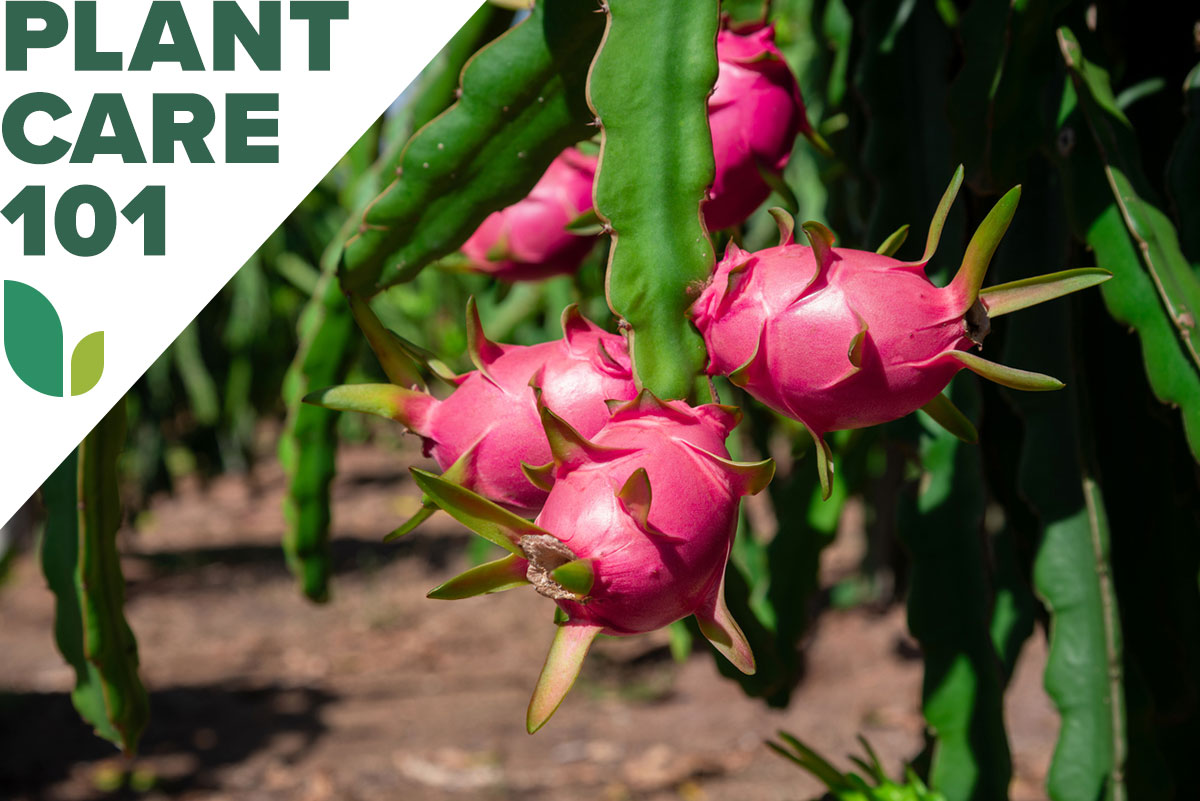

We may earn revenue from the products available on this page and participate in affiliate programs. Learn More ›
Like the mythical creature for which it is named, dragon fruit often has green scales on the outside and red flesh on the inside, though the colors vary according to cultivar. Since the cactus on which those fruits can be found is a fast-growing plant that depends on other plants for support and can become quite heavy, you don’t want it “eating up” any of your fair flowering trees. So, among the first things you should think about when considering how to grow dragon fruit is what kind of lair (resting place) you will give it.
RELATED: How To: Plant a Food Forest for Foraging at Home
Growing Dragon Fruit at a Glance
Common Name: dragon fruit, night-blooming cereus, pitahaya
Scientific Name: Hylocereus undatus and Selenicereus spp.
Hardiness Zone: 9-11
Soil: Fertile, well-drained
Light: Full sun to light shade
Water: Average in summer, low winter
Food: Palm fertilizer and composted manure
Propagation: Cuttings or seeds
Safety: Non-toxic but spiny
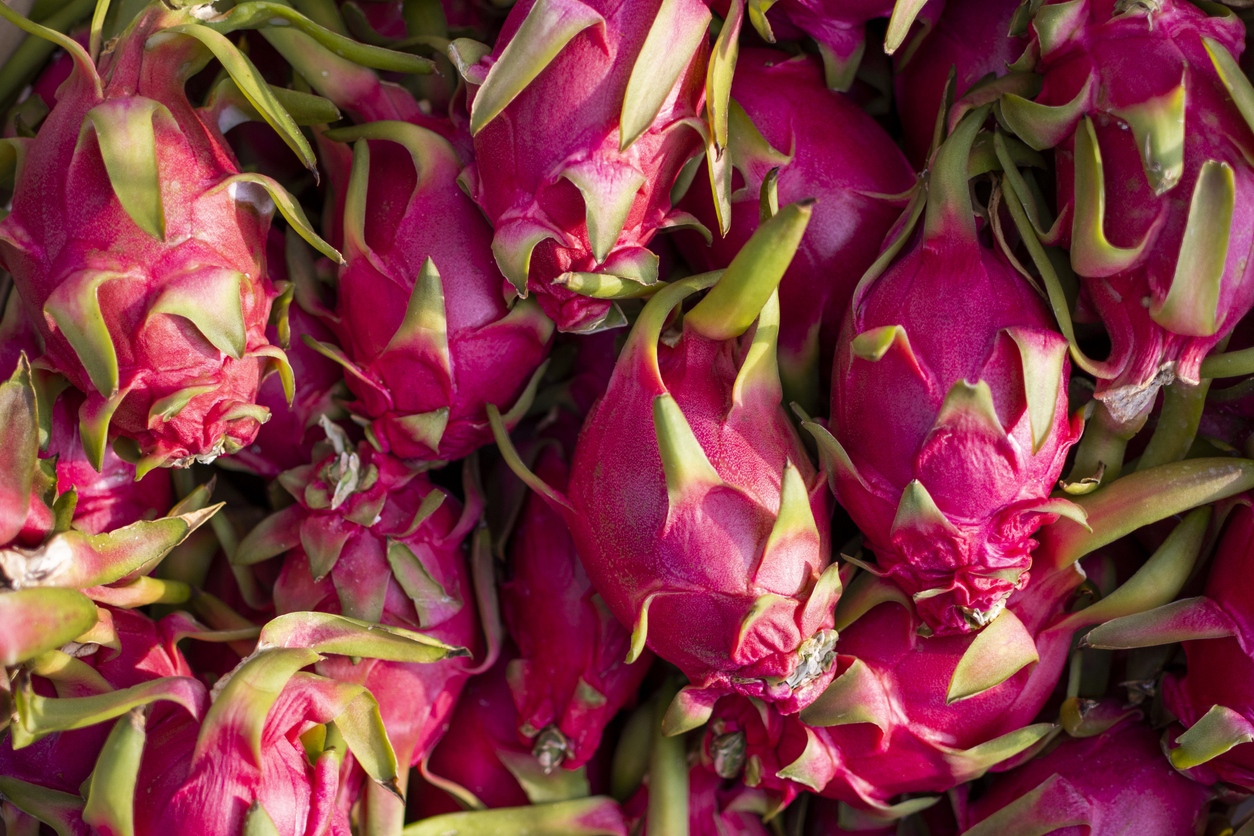
Dragon Fruit Characteristics
Native to southern Mexico, Central America, and South America, and sometimes called dragon fruit tree, the pitahaya cactus (Hylocereus and Selenicereus spp.) is an epiphytic plant in the wild, clambering over other trees or rocks to support itself via aerial roots. It can grow to 20 to 30 feet, with dangling 3- to 5-sided stems and spines in its nodes.
The dragon fruit bloom is a showy, usually white or pink, flower that can measure up to 16 inches across. Those blooms generally appear in spring or early summer to be followed by 4½-inch-diameter, egg-shaped fruits 37 to 48 days later. In addition to green “scales,” the fruits sport red, pink, or yellow coats and white, magenta, or red flesh peppered with tiny black seeds.
Although sometimes grown on horizontal wires as grapes are, dragon fruit plants sit more comfortably on platform-topped posts.
Recommended Dragon Fruit Varieties
- American Beauty: One of the self-fertile types of dragon fruit, American Beauty has pink skin and magenta flesh.
- Physical Graffiti: This cultivar requires cross pollination with another type and offers red skin and light magenta flesh.
- Yellow Palora: This self-fertile type with yellow skin and white flesh takes much longer to ripen fruit than most—up to six months.
Planting Dragon Fruit
Keep in mind that these succulent plants prefer tropical rather than desert conditions.
When is the best time to plant dragon fruit?
It’s best to plant dragon fruit in spring or early summer. However, since the cactus usually is grown only in frost-free zones, you should be able to get away with setting it out whenever you prefer. If you are starting your own cuttings, allow them to root for 4 to 6 months in a pot before transplanting them into the ground. Outdoor plants can tolerate occasional light frosts but will be killed by heavy freezes.
Where can dragon fruit grow?
Select a location in full sun to light shade that is at least 15 feet away from nearby trees and buildings and has fertile, well-drained soil. You will need a support composed of a durable vertical post—such as an 8-foot hardwood 4×4—topped with a small horizontal platform—such as a wooden or metal grid—for the plant to perch atop so that its branches can dangle down on all sides. If you plan to install multiple dragon fruit posts, space them 6 to 9 feet apart.
How do you plant dragon fruit?
After affixing your platform to the top of the post, set the post upright in the ground, with the lower third of its base buried in the soil.
- Dig a hole large enough to plant your cactus beside the post at the same depth it grew in its container.
- Insert the root ball into the hole.
- Backfill with the removed soil, mixed with a bit of compost.
- Apply 2 to 6 inches of woodchip mulch to the ground at least 2 feet out on all sides of the plant to protect it from lawn mowers and weed whackers.
- Place no more than four plants beside each post, one on each side.
Can you grow dragon fruit in containers?
If you live in a place where the plant isn’t hardy, you can grow it in a 16- to 18-inch diameter pot so it can be moved indoors over the winter. You’ll need to provide a support in the pot for the cactus to grow on—some folks have had luck with tomato cages.
Watering Dragon Fruit Plants
Since dry conditions help induce flowering, you may want to refrain from watering in-ground plants in spring until after they bloom and set fruits. From that time until you have harvested all of the fruits, you’ll want to keep the plants’ soil evenly moist but not soggy, so those fruits won’t split.
If growing dragon fruit in a container, you may need to water it at least twice a week during summer. However, you should decrease that amount during winter to only once a week or once every 10 days.
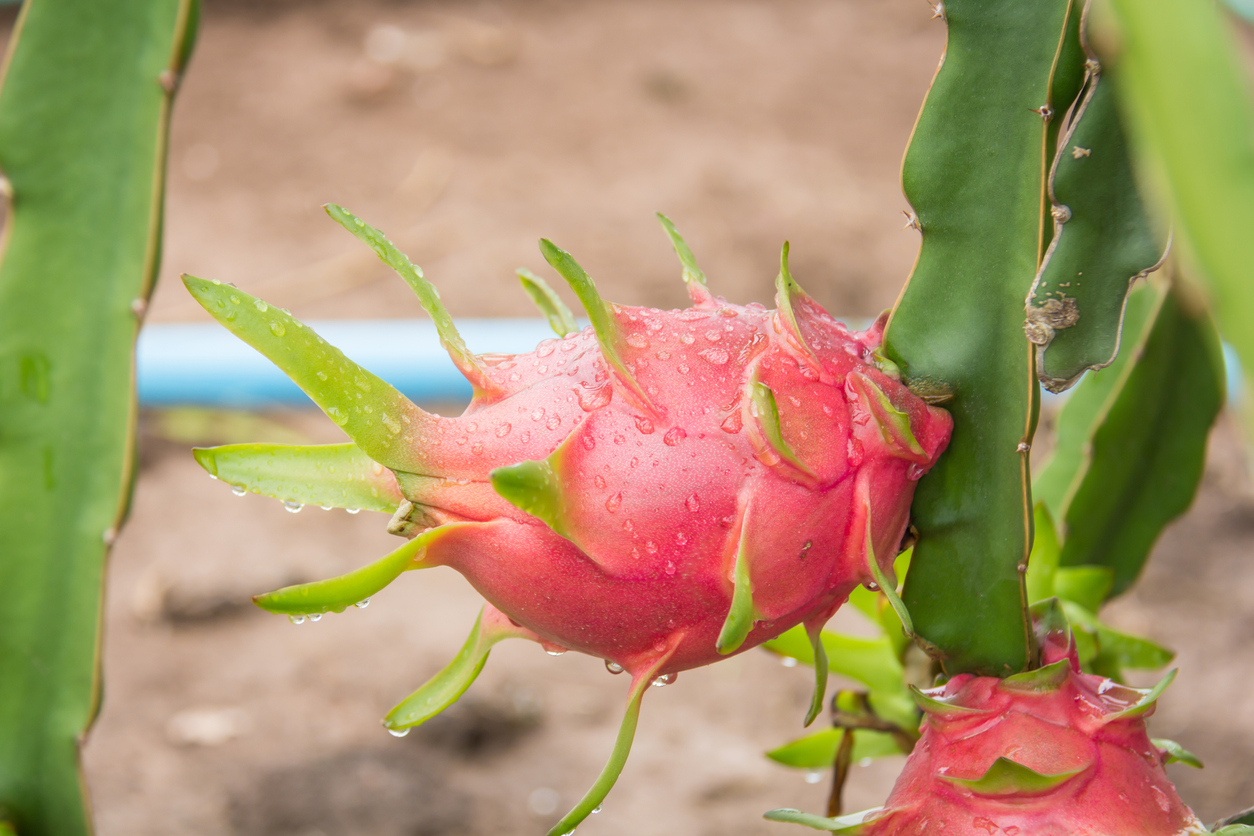
Fertilizing Dragon Fruit
The University of Florida Extension suggests that, about a month after setting out your plant, you should begin to feed it every 2 months with ¼ pound of an 8-4-12 palm fertilizer. As part of your dragon fruit plant care, you may also want to spread several pounds of composted manure around the base of the cactus—but not touching it—to accelerate growth. Gradually increase the amount of fertilizer until, by year 4, you are applying ½ pound at a time but only once every 3 to 4 months.
Pollination
Because dragon fruit plants bloom at night, they are pollinated in their native habitat by bats or moths. If nocturnal pollinators aren’t common where you live, you’ll need to pollinate the plants yourself. According to Growing Tasty Tropical Plants by Laurelynn G. Martin and Byron E. Martin, if you have a self-pollinating dragon fruit plant “you can simply brush your hand across the pistils and stamens of a flower.”
However, the University of Florida Extension recommends that you “plant 2 or 3 different genetic types (not the same clone or variety).” The extension service says that cross-pollination between the different types in the planting will assure a better fruit set and size.”
Pruning Dragon Fruit Plants
After you set out a plant, tie its main stem to its post. Prune off any side branches from that stem until it has grown to the point that its tip is 4 inches above the platform. Then prune back the main stem itself to make it branch out heavily over the surface of the platform.
At least once a year thereafter you should prune out any dead or damaged stems as well as cut back those that have dangled far enough to reach the ground. You may also need to thin the plant a bit by removing weak stems.
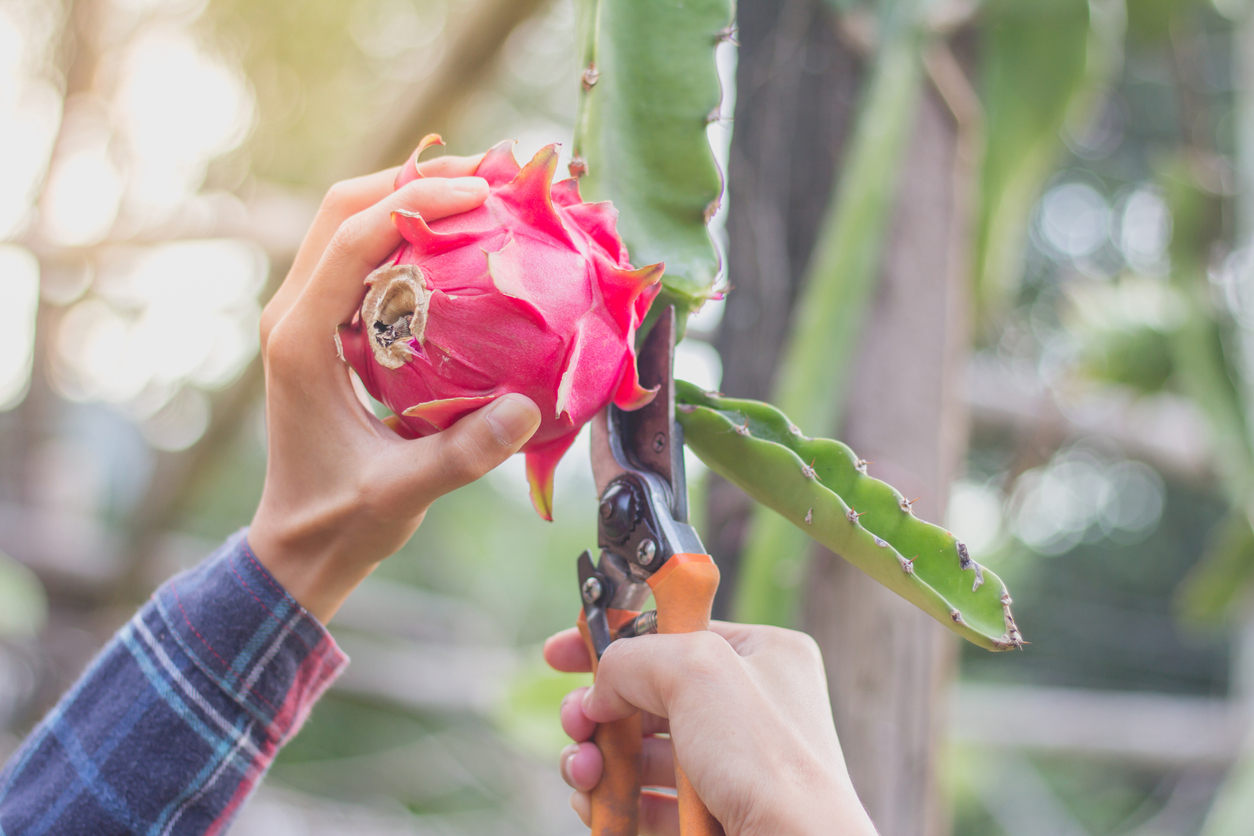
Propagating Dragon Fruit
It’s best to propagate dragon fruit cactus from cuttings, since they may fruit within a year after rooting, while plants grown from dragon fruit seeds often require 5 to 7 years to produce. Take 6 to 15 inch cuttings, snipping the base of each one at a slant, and allow them to dry in a shady location for a week before you dip their bases in rooting hormone and pot them.
Press seeds into the surface of damp seed-starting mix and keep the container in a warm, bright location until the seeds sprout in 2 to 4 weeks.
Safety Considerations
Both the flowers and fruits of the dragon fruit plant are edible, and the foliage is not toxic to either humans or pets. However, you will want to wear heavy gloves when handling the cactus to protect yourself from its spines.
It can grow very large and heavy as it matures. Therefore, if its post is not well secured, that support could topple, possibly injuring both the plant and any nearby people or animals.
Potential Pests and Diseases
Young dragon fruit plants in full sun may develop a case of “sunburn.” So, just after you plant them, cover them with a shade cloth which cuts 30 percent of the light that reaches them. Once they grow larger and less tender, you can gradually expose them to more light.
The main pest for your dragon fruit probably will be birds, who love the fruits as much as humans do. If you prefer to keep those “colored eggs” for yourself, you will need to drape netting over the plants or cover each fruit with a drawstring mesh bag.
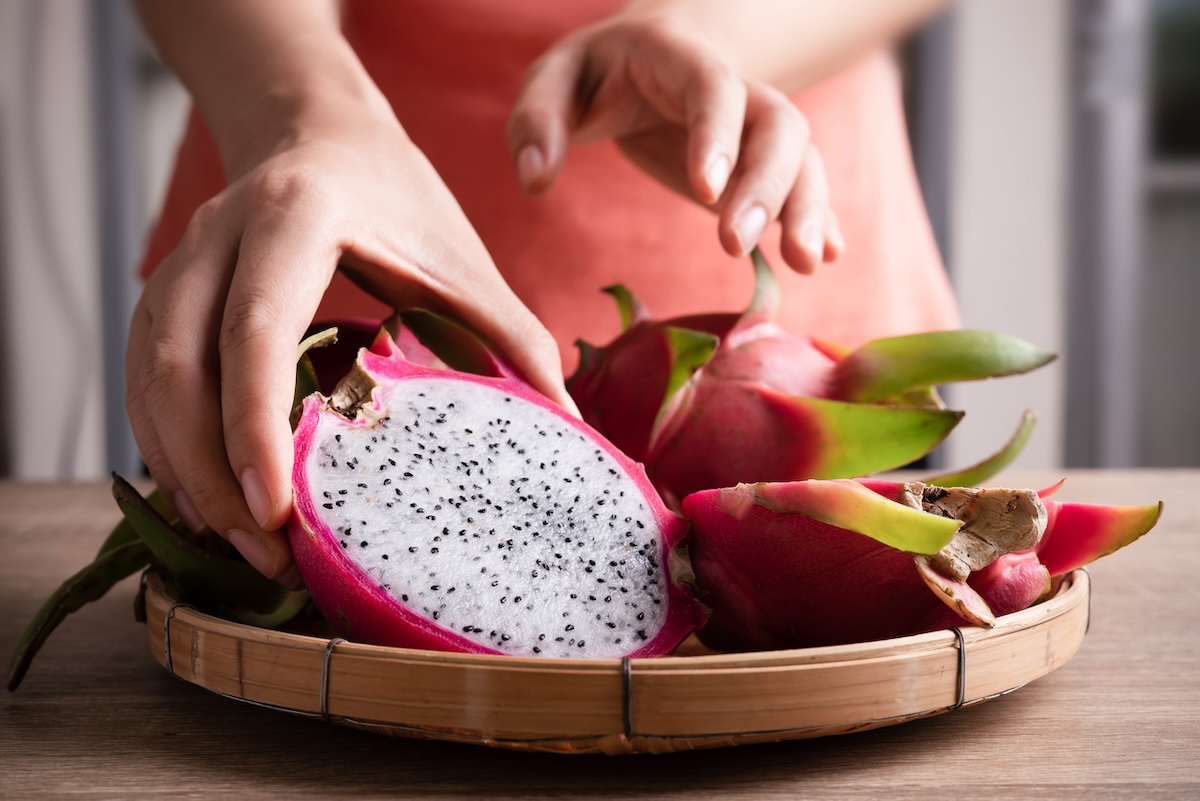
Harvesting Dragon Fruit
Although most dragon fruits can be harvested within 50 days after the plant’s flowering, others—especially those from Selenicereus megalanthus cultivars—may require 5 to 6 months to mature. According to the Martins, the dragon fruit plant typically doesn’t fruit until it has reached 4 to 5 feet in height.
When is the best time to harvest dragon fruit?
Dragon fruit season typically runs from summer through autumn. Dragon fruit ripeness is determined by age, with the produce of most cultivars ripening 37 to 48 days after the flowers fall. If a fruit releases from the plant easily when you twist it, it is ready. If it hangs on, you should wait a bit, since the fruits sweeten as they remain on the plant.
How do you harvest dragon fruit?
Protect your hands by donning a pair of leather gloves before you begin.
- Use pruning shears to snip a fruit’s stem close to the fruit, leaving no stem attached.
- Repeat this process with the other fruits.
- Determine whether you want to use them right away or should refrigerate them instead.
How do you store dragon fruit?
Dragon fruits will keep 4 to 5 days at room temperature but can last up to a month if stored in a perforated plastic bag inside your refrigerator. To eat, cut the fruit in half and scoop out the pulp with a spoon. Or, after cutting the fruit in half, peel off the skin and cut the fruit into chunks.
Looking for more fruiting plants? Check out our guides on growing elderberries, raspberries, and strawberries.
